I have a computational geometry problem that I feel should have a relatively simple solution, but I can't quite figure it out.
I need to determine the non-convex outline of a region defined by several line segments.
I'm aware of various non-convex hull algorithms (e.g. alpha shapes), but I don't need a fully general algorithm, as the line segments define a unique solution in most cases.
As @Jean-FrançoisCorbett has pointed out, there are cases where there are multiple solutions. I clearly need to think more about my definition.
However, what I'm trying to do is reverse-engineer and use a proprietary file format so that I can run basic analyses on data collected by myself and others. The file format is simple enough, but determining the algorithm they use to define the boundary is considerably harder.
Putting in many of the edge cases that would result in a non-unique solution causes the software in question to either crash without warning or silently fail to read the file.
Therefore, when there are multiple solutions, either generating one of the acceptable solutions or being able to determine that there are multiple solutions would be acceptable.
Problem Definition:
The polygon's outline should never cross any of the segments and should be formed of lines joining all of the segments' endpoints. All segments must lie entirely inside or along the boundary of the polygon. No endpoint may be used more than once in the outline (Ignoring "closing" the polygon by adding the first point at the end for software libraries that require polygons to close.).
In cases where there are multiple solutions that meet this criteria, any one of those solutions would be acceptable. (It would be nice to be able to determine when the solution is non-unique, but this isn't strictly necessary.)
Examples:
As an example, I have something along these lines:

And I'd like to delineate the following area:

It also should work for non-intersecting segments. E.g.


I think (?) there's a unique solution in either case, subject to the criteria outline earlier. (Edit: There isn't a unique solution in general, as @Jean-FrançoisCorbett pointed out. However, I'm still interested in an algorithm that would either generate one of the acceptable solutions.)
Test Cases
For a test case, here's the code to generate the above figures. I'm using python here, but the question is language-agnostic.
import matplotlib.pyplot as plt
def main():
test1()
test2()
plt.show()
def test1():
"""Intersecting segments."""
segments = [[(1, 1), (1, 3)],
[(3.7, 1), (2, 4)],
[(2, 0), (3.7, 3)],
[(4, 0), (4, 4)],
[(4.3, 1), (4.3, 3)],
[(0, 2), (6, 3)]]
desired_outline = [segments[0][0], segments[5][0], segments[0][1],
segments[1][1], segments[2][1], segments[3][1],
segments[4][1], segments[5][1], segments[4][0],
segments[3][0], segments[1][0], segments[2][0],
segments[0][0]]
plot(segments, desired_outline)
def test2():
"""Non-intersecting segments."""
segments = [[(0, 1), (0, 3)],
[(1, 0), (1, 4)],
[(2, 1), (2, 3)],
[(3, 0), (3, 4)]]
desired_outline = [segments[0][0], segments[0][1], segments[1][1],
segments[2][1], segments[3][1], segments[3][0],
segments[2][0], segments[1][0], segments[0][0]]
plot(segments, desired_outline)
def plot(segments, desired_outline):
fig, ax = plt.subplots()
plot_segments(ax, segments)
ax.set_title('Segments')
fig, ax = plt.subplots()
ax.fill(*zip(*desired_outline), facecolor='gray')
plot_segments(ax, segments)
ax.set_title('Desired Outline')
def plot_segments(ax, segments):
for segment in segments:
ax.plot(*zip(*segment), marker='o', linestyle='-')
xmin, xmax, ymin, ymax = ax.axis()
ax.axis([xmin - 0.5, xmax + 0.5, ymin - 0.5, ymax + 0.5])
if __name__ == '__main__':
main()
Any ideas?
I'm beginning to suspect that the software whose results I'm trying to reproduce uses a radial-sweep algorithm in some sort of "internal" coordinate system (e.g. A coordinate system with x-prime and y-prime scaled and rotated along the principal axes defined by the spread of points. This makes the problem more "circular".) However, this produces solutions where the outline intersects line segments in many cases. It's easy enough to detect this and brute force it from there, but surely there's a better way?

